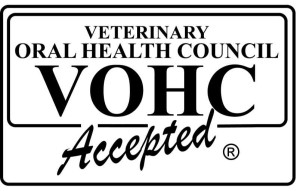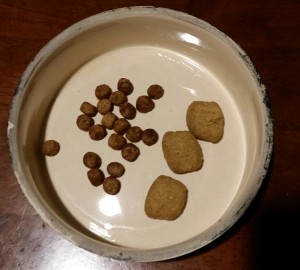In a perfect world, your pet saunters up to you, carrying his toothbrush in his mouth, requesting you brush his teeth while he calmly cooperates. Birds are chirping. The sun is shining.
We all know we don’t live in a perfect world. Some pets, no matter how slowly you try to ease them in, will not tolerate tooth brushing. At least not more than once. While tooth brushing is the best, many other options exist that can help keep your pet’s teeth healthy!
Stroll down the pet aisle of any store these days, and you’ll find an assortment of products all claiming to freshen breath, clean teeth, etc. Is there a way to know which ones actually work? For once, there is! (Maybe this world just got a little closer to perfect after all!)
In terms of product labeling, there is minimal enforcement in terms of truth. If every product claims to be miraculous, which ones are most likely to actually help? There is a simple seal you can look for on the package to separate the effective from the…..not….so….effective, to put it nicely.
The VOHC seal on the product’s packaging is our best bet in picking out a dental health product.  The Veterinary Oral Health Council is a group of ten very experienced and dedicated individuals. The majority of them are veterinarians who went on to complete a residency after vet school. After their dental residency, (vet school wasn’t enough torture?) they had to pass another exam and become board certified dental specialists. These veterinary specialists have created a regimen of testing for any product to earn the VOHC seal of approval. Two separate trials must be performed, and the requirements for the design of these trials is rather strict. They want to make sure the products do what they say – no cheating!
The Veterinary Oral Health Council is a group of ten very experienced and dedicated individuals. The majority of them are veterinarians who went on to complete a residency after vet school. After their dental residency, (vet school wasn’t enough torture?) they had to pass another exam and become board certified dental specialists. These veterinary specialists have created a regimen of testing for any product to earn the VOHC seal of approval. Two separate trials must be performed, and the requirements for the design of these trials is rather strict. They want to make sure the products do what they say – no cheating!
Furthermore, the seal doesn’t just say “approved,” but it also specifies the nature of the product. Is this dental chew removing plaque or tartar? Big difference between those two! (Here’s my article about the difference between them).
It used to be that most VOHC accepted products were pretty much available from veterinarians only, and that was a bit of a buzz-kill. Good news – nowadays many accepted products can be purchased off store shelves almost anywhere! Here’s the list of current VOHC products. Note they list dog products first, and cat products below.
This list should let pet owners breathe a little easier. On this list are everything from chews and treats to sprays and gels. Surely you’ll find a product you and your pet can agree on.
One of my personal favorites is the prescription diet t/d, made by Hill’s Science Diet. No, they didn’t pay me to say this (although I wouldn’t turn down an offer!) but I truly love this diet. Well, I love this diet for my pets.

Average sized dog food is on the left, and the t/d food is the 3 large pieces on the right.
I do not use it as my pets’ entire food, but as treats, and I suggest this technique to many of my clients. I decrease their regular food by a calculated amount, and replace it with the t/d food throughout the day, or on top of their food at meals. I like this food/treat because it is a very large kibble. Inside it is a matrix that does not break down when chewed, like most kibble. Instead, it stays firm and “scrubs” the teeth while they chew, making it great for the back “chewing” teeth! But, full disclosure, the teeth in front (the fang teeth and others they really do not chew with) don’t see much action. Therefore, they will not get the cleaning benefit like the back teeth will.
Unfortunately, this food is considered “prescription” so your veterinarian must be in agreement on feeding it to your pet. Yes, it comes in cat version, as well as regular and small-breed dog formulas.
The VOHC also lists a few good products that are readily available for anyone, without a prescription. Greenies have been reformulated to dissolve in digestive tracts and not cause blockages. (Here’s my urban legend article on that). Milk Bone brushing chews are easily found in large box stores and slightly less costly than other options (none are cheap). And with the internet, pretty much anything can be delivered to your house.
What if your pet loves a dental chew that doesn’t have the VOHC accepted seal? Is it bad? Not necessarily. Some products might be good, but choose not to go through the rigorous trials. If you have a product you’ve been using and liking, and your veterinarian says your pet’s teeth are in great shape, why change it? One sticking point – if your pet is overweight from eating a large amount of dental treats and chews, we may need a new strategy. Here’s my weight loss tips and tricks.
I love your blog. It’s so informative!